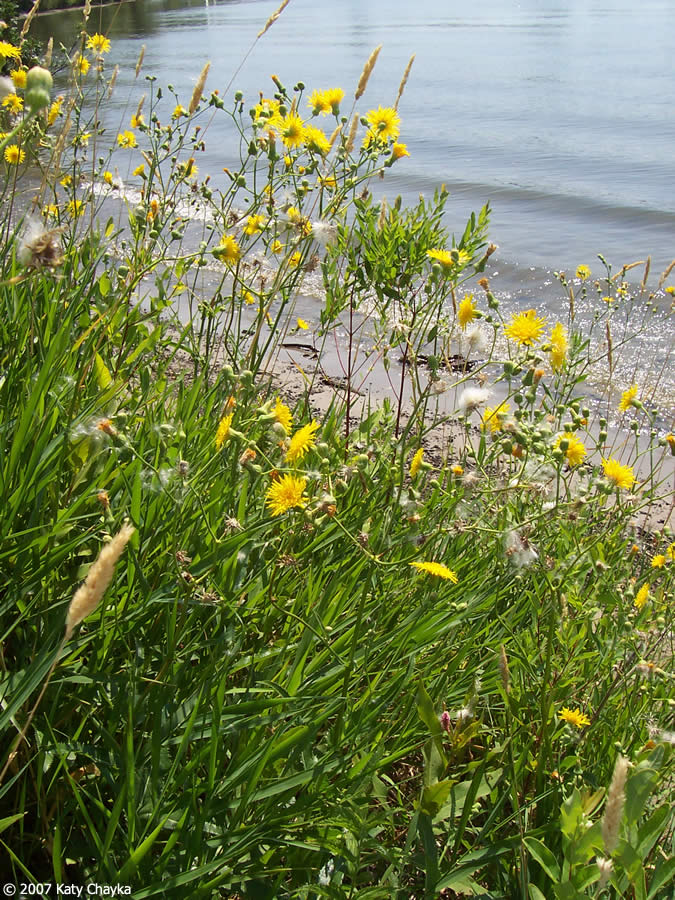A-Z
Disclaimer: do not eat any plant unless you can be certain it has been correctly identified. Do not remove plants from another person's property, or eat plants from polluted areas such as beside roads. Do not consume plants that are being treated with herbicides, and be mindful that consuming any food for the first time may trigger unexpected allergic reactions.
Canada thistle - Cirsium arvense

Idenitifcation
Up to 2m tall. Shiny green leaves with spiny edges. and white hairs on the underside. Clusters of up to five flowers. You can tell Canada thistle from all similar species by its smooth main stem and small flowers.
Edible Parts
Young leaves and shoots can be eaten raw or cooked. Thorns must be removed before eating. The entire plant is edible. Roots taste of lettuce. Stems are best eaten before flowers appear, otherwise they are stringy and hollow.Peeled flowers are edible and similar to artichokes, but generally considered "not worth the effort."
Cautions
All thistles are edible, but ensure that you do not harvest native thistle species, which look similar.
Look Alikes
Most thistles in the genus Cirsium
Cooking
A green soup base can be made from blanched leaves.
Narrowleaf Hawksbeard - Crepis tectorum

Idenitifcation
Its basal leaves are coarsely toothed, pointed, up to 15cm long, and form a rosette. As leaves ascend the stem, they lose this shape and progressively become smaller, narrower, and toothless. The stems branch near the top and have clusters of up to 20 flowers, which are smaller than dandelion flowers but look similar.
Edible Parts
Young leaves are edible when cooked.
Cautions
None known.
Look Alikes
dandelion
Prickly sow thistle
Sow Thistle
Cooking
Young leaves are generally a substitute for spinach in any recipe.
Oxeye daisy - Leucanthemum vulgare

Idenitifcation
Oxeye daisy has single white flowers at the end of stems that contain 20-30 petals and a yellow center. Stems range from 20 to 80cm in height and have wavy leaves that clasp toward the stem.
Edible Parts
Flowers can be dried and used as tea, and flower buds can be eaten raw or pickled. Roots can be eaten raw in the spring. Leaves can be eaten raw or cooked, but their flavour is not well-loved.
Cautions
Oxeye daisy can cause allergic reactions in people with ragweed or pollen allergies.
Look Alikes
Shasta daisy
Other asters
Scentless chamomile (also invasive), not generally considered edible.
Cooking
Leaves and flower buds can be used in salads.
Flower buds can be pickled.
Flowers can be dried and used in tea.
Perennial Sow Thistle - Sonchus arvensis

Idenitifcation
Sow thistle looks like a tall dandelion with many flowers sprouting out on each stalk. Its leaves grow from the the base of the plant all the way up the stalk. The stems are unbranched until the top of the plant where the flowers grow.
Edible Parts
Leaves and shoots are edible, but only palatable when young. The young root can be roasted and ground as a coffee substitute.
Cautions
Remove spines before eating!
Look Alikes
dandelion
Prickly sow thistle
Narrow-leaved Hawksbeard
Cooking
Young leaves are generally a substitute for spinach in any recipe.
Sweet Clover - Melilotus
white sweet clover (Melilotus albus) and yellow sweet clover (Melilotus officinalis) are both invasive in YK.

Idenitifcation
Both: Grows to 3m tall and sweet-smelling. Leaves are alternate, divided into 3 leaflets, elliptic to oblong. Flowers are 4-6mm long, numerous, tall and narrow, and grow in clusters.
Yellow Sweet Clover: It has a strong taproot, freely branched stem that is hairless or with sparse, fine, flat, stiff, very short hairs. Flowers are yellow.
White Sweet Clover (pictured): Stem that is hairless. Flowers are white.
Edible Parts
Both species have similar edible properties. Young shoots can be cooked and used like asparagus. Young leaves can be eaten in salads and the leaves and seedpods cooked as a vegetable. They have also been used as a flavoring. The flowers, raw or cooked, are edible. The flowers and seeds can be used as a flavoring. The flowers also give an aromatic quality to some tisanes.
Yellow sweetclover roots were consumed as a food by the Kalmuks White sweetclover root is not known to be edible.
Cautions
The dried leaves can be toxic! Fresh leaves are quite safe to use, but if they have dried, and especially if they smell like hay, discard them.
Look Alikes
Other sweet clovers
Alfalfa (before flowering)
Cooking
Use the flowers to flavour a lemonade
Yellow Toadflax- Linaria vulgaris

Idenitifcation
Yellow, 3cm long, snapdragon-like flowers with an orange throat that grow in an elongated cluster. Hairless leaves and stems. Alternate, toothless, "grass-like" leaves with pointed tips and no leaf stalk. Leaves can be tightly packed along the stem so may appear opposite or whorled.
Edible Parts
Young shoots are edible when cooked.
Cautions
There is debate over whether this plant is toxic. It may be moderately so, thus it is best to eat with caution and not to over-indulge.
Look Alikes
dalmatian toadflax (also invasive, but known to be poisonous to some livestock).
Snapdragon
Cooking
If you don't want to chance its possible toxicity, yellow toadflax can also be used as a yellow dye, or brewed into a tea and used as an insecticide.
Is something missing? Let us know.
Images and identification information courtesy of the Yukon Invasive Species Council, the Invasive Species Council of British Columbia, and Minnesota Wildflowers.